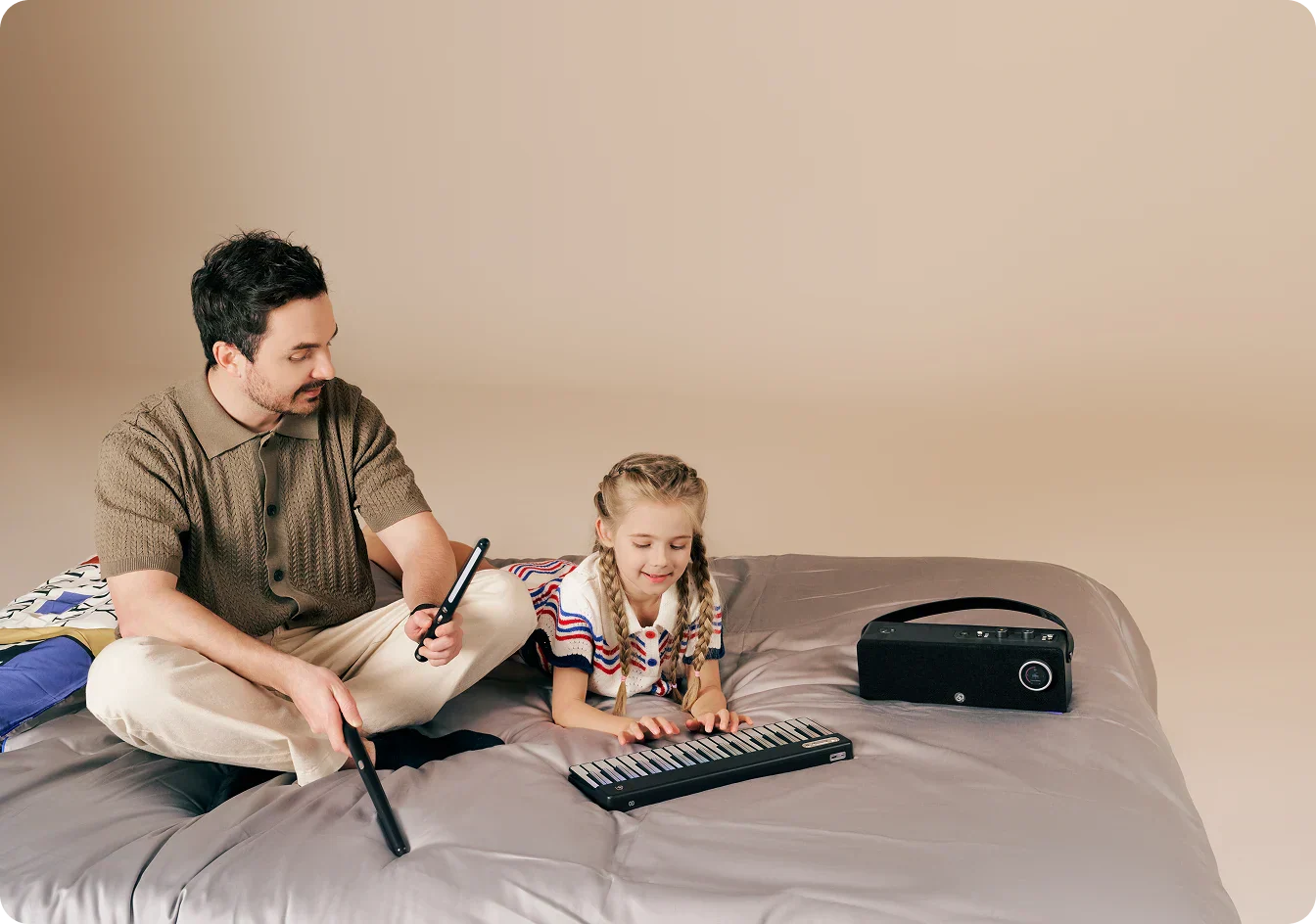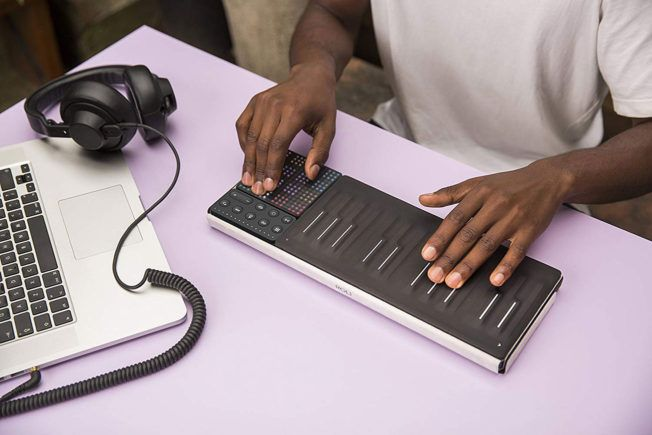Busy life, big goals, not much time—that’s the adult learner’s reality. The good news? You can build real piano skills with a focused beginner piano plan for adults that fits into 10–30 minutes a day.
This guide gives you a clear roadmap: the exact routine to follow, what to practice first, how to choose a beginner-friendly instrument, and when to level up. We’ll keep the tone practical and encouraging, and we’ll focus on small wins that stack up fast.
Why adults can learn quickly (even with 10 minutes a day)
Adult learners bring advantages: better focus, clear music goals, and the discipline to show up. Your brain forms motor “maps” every time you practice; frequent, short sessions hard-wire those maps faster than occasional long ones. That’s why this plan favors beginning piano for adults built around daily micro-sessions and simple, repeatable steps.
Progress pillars
-
Consistency over duration: 10–20 min daily > 2 hours once a week.
-
Guided feedback: Follow-lights, app tracking, and simple checklists remove guesswork.
-
Song-first approach: Start with music you love; weave technique into songs.
Your 10-Minute Routine (Busy-Day Version)

When time is tight, run this exact flow. It’s designed for piano lessons for adult beginners who need results without overwhelm.
-
60 seconds — Posture & warm-hands: Sit tall, wrists neutral, shoulders relaxed. Play five gentle ascending/descending finger patterns (5-note scale) in C and G.
-
3 minutes — Scales or finger patterns: One octave, hands separate. Rotate keys daily (C → G → D → F). Keep it slow; aim for even tone.
-
2 minutes — Arpeggios or broken chords: Pick one key (today’s scale). Right hand only on busy days. Focus on curved fingers and steady tempo.
-
2 minutes — Chord shapes & inversions: C, F, G major in root, first, second inversion. Say chord names quietly as you play. This powers pop progressions.
-
2 minutes — Song chunk: Choose one 2–4 bar section. Loop slowly with a metronome or app. If you use a keyboard with lights, follow the guide until it’s smooth.
Your 25-Minute Routine (Standard Day)
When you can spare a bit more time, expand to a balanced session for piano learning for adults:
-
5 min Technique: One scale (hands separate), one arpeggio, one chord family.
-
10 min Song A: Learn 2–4 bars, hands separate → hands together (slow).
-
7 min Song B: Review a previous chunk at a slightly higher tempo.
-
3 min Creativity: Record a loop, try a simple left-hand pattern, or improvise on a 4-chord progression.
Week-by-Week Roadmap (First 30 Days)

This is the structured adult beginner piano plan you can print and follow.
Week 1 — Setup & first melody
-
Goal: Right-hand melody + steady timing.
- Tasks:
- Choose one favorite song with a clear melody.
- Learn two short sections (2–4 bars each).
- Practice C and G major scales (RH only).
-
Checkpoint: You can play a full 8 bars with even timing at a slow tempo.
Week 2 — Add chords & hands-together moments
-
Goal: Left hand plays simple chords or fifths.
- Tasks:
- Learn C–G–Am–F chord shapes (root position).
- Add LH whole-note or half-note chords under your melody.
- Practice D and F major scales; C arpeggios (RH).
-
Checkpoint: One verse hands together, slow but steady.
Week 3 — Smooth transitions & inversions
-
Goal: Less jumping between chords; more musical flow.
- Tasks:
- Learn first and second inversions of C, F, G.
- Replace big jumps with nearest-inversion moves.
- Expand to the chorus; record a draft.
-
Checkpoint: Verse + chorus hands together at practice tempo.
Week 4 — Build a mini-set & share it
-
Goal: Confidence and continuity.
- Tasks:
- Add a second simple song or a different style (ballad vs upbeat).
- Raise tempo by 5–8 BPM every other day without tensing up.
- Film a one-take video for your future self.
-
Checkpoint: Two songs at comfortable tempo; clear improvement on tone and timing.
Lead sheets: the adult-friendly way to play songs sooner
Reading both staves is useful, but it can stall beginners. Lead sheets simplify beginner piano lessons for adults:
-
Right hand: Plays the written melody.
-
Left hand: Plays the chord symbol (C, G, Am, F) as whole notes, fifths, or broken patterns.
-
Result: You sound musical quickly, while learning real harmony.
Three left-hand options (ranked easiest → richer):
-
Whole notes/fifths (C–G–C)
-
Broken chord 1–5–8 (arpeggio feel)
-
Rhythmic comping (split the chord across the bar)
The adult beginner’s song blueprint (15-minute workflow)

-
Listen once to the original; hum the melody.
-
RH only: Learn 2 bars; loop slowly with a metronome or app.
-
LH only: Play root or fifths on downbeats (or use a chord pad if your keyboard has one).
-
Hands together: Combine the same 2 bars; ignore mistakes, keep timing.
-
Repeat for the next 2 bars; then stitch sections.
-
Refine: Increase tempo slightly; add dynamics (soft vs strong).
-
Save a clip—progress tracking is fuel.
Technique that matters (and what you can skip for now)
Worth your time (5–10 min/day):
-
Scales: C, G, D, F—hands separate first.
-
Arpeggios: Match the song’s key when possible.
-
Chord inversions: For smooth left-hand movement.
Safe to delay:
- Advanced fingerings across multiple octaves
- Complex theory deep dives
- Heavy pedal work before your timing is solid
Gear that helps adults stick with it
You don’t need a full acoustic. A compact, beginner-friendly board keeps the habit alive and sounds great through headphones.
-
Lighted keys / visual guidance: Lowers the barrier on day one.
-
App lessons with progress tracking: Turn practice into short, winnable levels.
-
Headphone jack + Bluetooth/USB-MIDI: Quiet practice and easy recording.
-
Portability: If it fits on your desk, you’ll actually use it.
-
Room to grow: Extra keys or add-on modules help when two-hand pieces appear.
A realistic 10-to-30 minute planner (print this)

Mon / Thu — Song Build
- 5 min: Scale + arpeggio in the song’s key
- 10–15 min: New 2–4 bar chunk (hands separate → together)
Tue / Fri — Groove & Review
- 5 min: Chord shapes + inversions
- 10–15 min: Review yesterday’s chunk, +5 BPM if clean
Wed — Creativity
- 5 min: Warmup
- 10–20 min: Record a loop, try a left-hand pattern, improvise on I–V–vi–IV
Sat — Stitch & Share
- 10–20 min: Stitch song sections, film a one-take at practice tempo
Sun — Rest or Listen
Troubleshooting for adult beginners (quick fixes)
-
Hands together falls apart: Practice RH alone to 95% clean; LH as whole notes only; then combine.
-
Rhythm wobbles: Clap the rhythm first; set the metronome lower than you think; count out loud.
-
Chord jumps are messy: Use nearest inversion rather than jumping back to root every time.
-
Can’t find time: Anchor practice to a daily habit (coffee break), and keep the keyboard out on your desk.
-
Motivation dips: Rotate in a 30-second “win” piece you can nail today.
Micro-skills that compound fast
-
Loop & slow-down: Work in 2-bar loops at 60–70% speed; add 5 BPM only when clean.
-
Phrase breathing: Lift slightly at phrase ends; play the melody like a singer.
-
Dynamic islands: Choose one bar to play softer, one bar louder—music comes alive.
-
Left-hand patterns: Whole notes → fifths → broken chords → rhythmic comping.
Frequently asked questions
How much should an adult beginner practice?
Aim for 10–20 minutes daily. Consistency matters more than length at this stage.
Do I need weighted keys?
Nice, not necessary. For beginner piano for adults, focus on guidance (lights/app), timing, and chord fluency. You can upgrade later.
Is reading sheet music required at first?
No. Lead sheets are perfect for piano lessons for adult beginners. You’ll still learn theory—just in a song-first way.
What’s a reasonable first-month goal?
One full song at a comfortable tempo, hands together, with clean chord changes and steady timing.
Can I learn with headphones only?
Absolutely. Quiet practice is a superpower for busy adults.
The simple path forward (and why it works)
A great beginner piano plan for adults keeps friction low. Use lighted guidance or a clear app, pick songs you love, and stick to short, daily sessions. Build technique inside real music, not apart from it. In four weeks, you’ll hear improvement in tone, timing, and confidence—and you’ll be ready to tackle a second song with half the effort.






